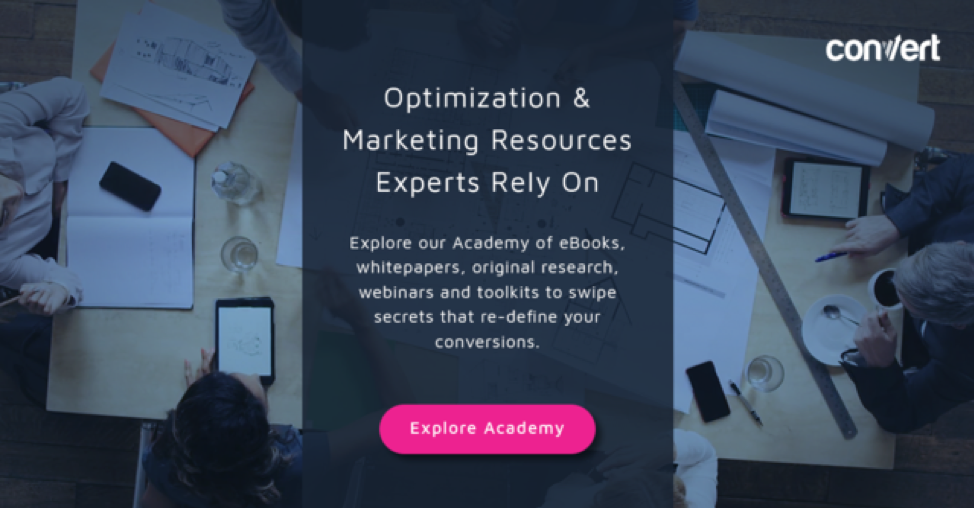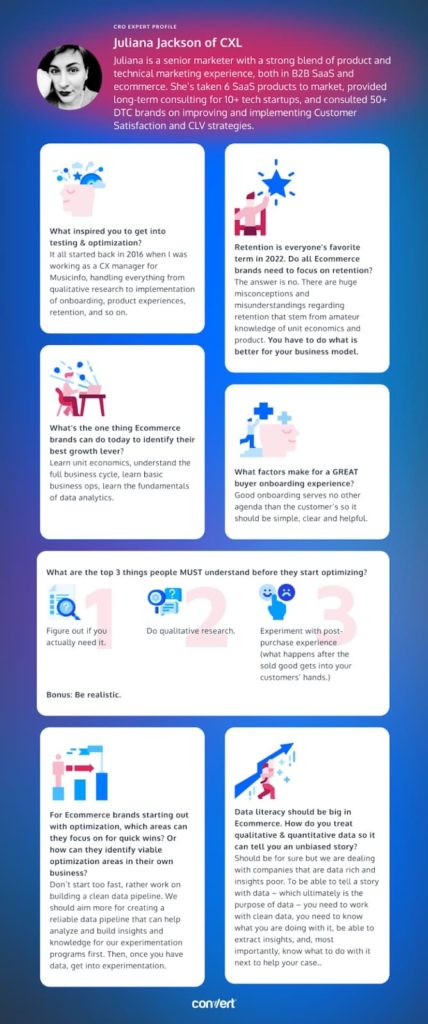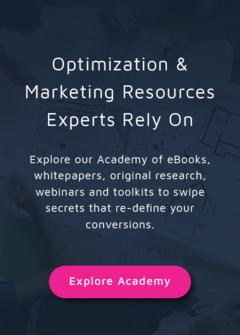Mind Map Series Special: Optimization & Retention in Ecommerce
Interview with Juliana Jackson of CXL
What is the best way to optimize your ecommerce store? There is no one right way to do things in ecommerce. With so many moving parts, it can be difficult to know where you should focus your attention.
While acquisition and retention usually come to mind when we think about driving sustainable, long-term growth in any business, there’s no one size fits all strategy. Understanding the full business cycle, business model and unit economics should be at the core of any business. That is the position Juliana Jackson takes. She says these are all areas that tie into understanding the customer and building a healthy data pipeline to feed your experimentation programs.
In this interview, Juliana takes us through her process for tackling this issue strategically.
Here goes…
Tell us about your journey, CLV lady… how did Juliana get here?
Well, my story is pretty long. But it all started back in 2016 when I was working for Musicinfo. The company was selling music distribution in China to music artists. Besides being a fun period of time, and having to deal with my fav thing in the world besides food – music, I was working as a CX manager, meaning I was handling everything from qualitative research to implementation of onboarding, product experiences, retention, and so on.
Before this role, I was working mostly in product management and product marketing projects so this layer of “customer experience” has only made me a better product manager. And then is when I joined Omniconvert as a Product Owner for a new software. I took that software to market but my “skill” on creating buzz, evangelism, and go-to-market has shortly moved me from a full product role to a product marketing role. And from there, I guess because I couldn’t stop talking about CLV – I got this CLV lady nickname.
The pandemic changed “everything” for Ecommerce. Brands are still struggling to wrap their heads around what hit them. What’s the one thing they can do today to identify their best growth lever?
It was not only for ecomm, but for customer behavior in general.
That is why I do not trust any benchmarks and reports that talk about customer behavior post-2019. We are still yet to figure out the magic answer.
However, as I said before, if you are looking into getting into ecommerce marketing or, becoming a better ecommerce growth marketer, learn your unit economics, understand the full business cycle, learn basic business ops, learn the fundamentals of data analytics.
Retention is everyone’s favorite term in 2022. Do all Ecommerce brands need to focus on retention?
I have actively participated in that happening and the answer is no.
There are huge misconceptions and misunderstandings regarding retention that stem from amateur knowledge of unit economics and product. You have to do what is better for your business model.
Some businesses thrive on retention, the ones that sell items that are consumable or need replenishment. Other businesses cannot survive on retention, the ones that are selling just an SKU or a product with a high lifetime value (product lifetime value, not to be confused with CLV).
If they have to, what are the 3 things Ecommerce brands can try to bake retention into their business strategy?
- Figure out if you actually need it.
- Do qualitative research.
- Experiment with post-purchase experience (what happens after the sold good gets into your customers’ hands.)
Bonus: Be realistic.
Data literacy should be big in Ecommerce. How do you treat qualitative & quantitative data so it can tell you an unbiased story?
Should be for sure but we are dealing with companies that are data rich and insights poor.
And the few companies that hire data tools and data resources (people) are keeping them just a token of being data driven. Like that autographed Michael Jackson album that you keep in your house and you pull out when people are over to show how eclectic you are.
I think there is a time and place for anything when it comes to data. To be able to tell a story with data – which ultimately is the purpose of data – you need to be able to accurately and “cleanly” collect, store and report on it. This means that you need to work with clean data, you need to know what you are doing with it, be able to extract insights, and, most importantly, know what to do with it next to help your case.
You can measure a lot of stuff, doesn’t mean it’s gonna be also useful.
What factors make for a GREAT buyer onboarding experience?
Onboarding in general is highly dependent on product and business model.
However, as a rule of thumb, onboarding should be empathetic. Deeply rooted in the customer’s actual reality and not the one we experimenters want to create.
Good onboarding serves no other agenda than the customer’s so it should be simple, clear and helpful.
For Ecommerce brands starting out with optimization, which areas can they focus on for quick wins? Or how can they identify viable optimization areas in their own business?
Don’t start too fast, rather work on building a clean data pipeline.
As experimenters, we wanna go granular AF however using a handful of CDPs, CRMs or dashboards will really make any effort for consumer behavior granularity an overkill.
We should aim more for creating a reliable data pipeline that can help analyze and build insights and knowledge for our experimentation programs rather than being distracted by 5-10 dashboards that probably show us things we would never think about using.
Then once you have data, get into experimentation, or take the CXL Conversion Optimization Minidegree and equip yourself with the right frameworks, skills and mindset to become a successful optimizer.
Download the infographic above to use when inspiration becomes hard to find!
Hopefully, our interview with Juliana will help guide your optimization strategy in the right direction! What advice resonated most with you?
And if you haven’t already, check out our series of interviews with the brightest minds in CRO.

Written By
Juliana Jackson

Edited By
Carmen Apostu


